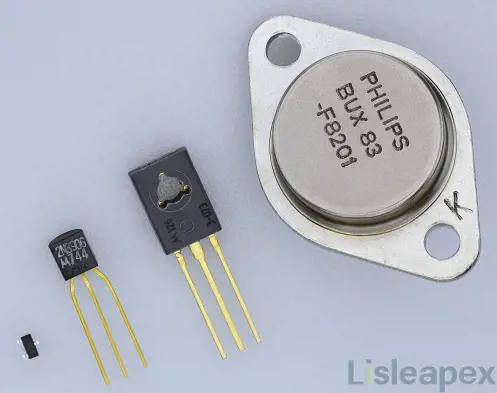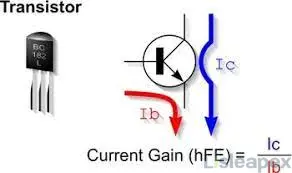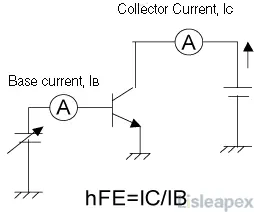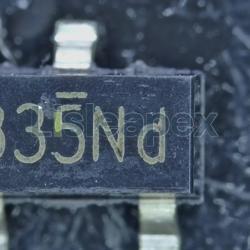Transistors, the fundamental building blocks of modern electronics, have a crucial parameter known as HFE, which stands for "DC Current Gain" or "Forward Current Transfer Ratio." This parameter plays a pivotal role in determining the amplification capability of a transistor. Understanding HFE is essential for engineers, hobbyists, and enthusiasts delving into circuit design and analysis.

What is HFE of a Transistor?
The hfe of a transistor stands for its "hybrid parameter forward current transfer ratio" or more commonly referred to as its "DC current gain." It's a crucial parameter used to describe the relationship between the input current and the output current of a bipolar junction transistor (BJT) in its active region.
What you Need to know
1. Current Gain: Current gain refers to the ratio between input current and output current in an electronic component or circuit. It describes the degree of current amplification in a circuit and is an important indicator for measuring the amplification effect of electronic components or circuits.
2. BJT: A Bipolar Junction Transistor (BJT) is a three-terminal semiconductor device that consists of three layers of doped semiconductor material. These layers are the emitter, base, and collector, hence the name "bipolar" as it involves both types of charge carriers: electrons (majority carriers in NPN) and holes (majority carriers in PNP).
Mathematically, hfe represents the ratio of the collector current (IC) to the base current (IB) when the transistor is operating in its active or linear region. It's expressed as:
hfe = IC / IB

This parameter essentially indicates how much the input current at the base of the transistor is amplified to produce the output current at the collector. For example, if hfe is 100, it means that for every 1 unit of base current, the collector current will be 100 times that amount (assuming the transistor is operating within its specified conditions).
The hfe value is not constant and can vary based on several factors such as temperature, collector current, and individual transistor characteristics. It's typically provided in the transistor's datasheet and helps engineers design circuits by predicting the transistor's behavior in amplification and switching applications.
HFE Formula in Transistors
The formula for the hfe, also known as the current gain or β (beta), of a bipolar junction transistor (BJT) is crucial in understanding its amplification capability. Mathematically, it's expressed as the ratio of the change in collector current (∆IC) to the change in base current (∆IB):
hfe = IC / IB
Here's a breakdown of the components in this formula:

HFE (β): Represents the current gain or amplification capability of the transistor.
∆IC: Change in collector current. It's the difference between the collector current when the transistor is in operation and the collector current when it's not.
∆IB: Change in base current. Similar to ∆IC, it's the difference between the base current when the transistor is in operation and the base current when it's not.
Factors Influencing HFE:
- Temperature: Higher temperatures tend to decrease HFE due to increased charge carrier energy, leading to higher recombination rates and reduced current gain.
- Manufacturing Variations: Differences in the manufacturing process can result in slight discrepancies in HFE values among transistors produced in the same batch.
- Operating Conditions: Changes in collector-emitter voltage (VCE) and collector current (IC) can significantly impact HFE.
Applications of the HFE Formula:
- Amplifier Circuit Design: Helps achieve desired voltage and current gain.
- Biasing Conditions: Assists in creating stable biasing for transistor circuits.
- Feedback Networks: Useful in designing control systems.
- Performance Optimization: Helps optimize oscillators, filters, and other analog circuits.
Understanding the HFE formula is vital for engineers as it aids in selecting the right transistor for specific applications and optimizing the performance of electronic circuits. Calculating HFE involves comparing changes in collector and base currents, making it a fundamental aspect of transistor analysis and design.
How HFE Works?
HFE (i.e., DC current gain) is an important parameter describing the amplification characteristics of a bipolar transistor (BJT), and represents the ratio between the collector current (IC) and the base current (IB).
The principle of operation of HFE involves the internal structure of the BJT and semiconductor physics:
Basic Function:
A BJT is a three-terminal device consisting of three layers of doped semiconductor material, including the emitter, base, and collector.
The BJT is in operation when the base-emitter junction is forward biased and the collector-base junction is reverse biased.
Current Amplification:
HFE is the ratio of the collector current (IC) to the base current (IB) of the BJT in the operating state. It expresses the relationship between the base current input to the transistor and the current output to the collector.
Principle Description:
The base current controls the flow of charge from the emitter to the collector. A small base current can affect the flow of a large number of charge carriers (electrons or holes).
A large HFE value means that the transistor can control a large collector current with a small base current. For example, an HFE value of 100 means that for each unit of base current, the collector current will be amplified 100 times.
Circuit Design:
Engineers use the HFE value in circuit design by calculating and predicting the behavior of BJTs in electronic circuits such as amplifiers. This helps in selecting appropriate bias, resistor values and transistor configurations to achieve desired performance.
Practical Application:
HFE values vary with temperature, set current and manufacturing tolerances. Therefore, manufacturers provide a range of HFE values in their datasheets to accommodate these variations.
Different Kinds of Transistor Gain: hFE, hfe, beta, β
The gain of a transistor is one of the most important specifications in electronic circuit design. Three specifications are commonly seen in bipolar transistors: beta β, hFE, and hfe, each slightly different.
Beta; β: the basic symbol for the forward current gain of a transistor, widely used in many electronic circuit design calculations.
hfe: the current gain of a transistor, expressed as an h-parameter (hybrid parameter). The letter f indicates that this is a forward transfer characteristic, and the letter e indicates a common-emitter configuration. The lowercase letter h indicates that this is a small-signal gain. hfe is the same as small-signal Beta. This number is widely used in transistor data sheets and circuit design calculations.
hFE: The hFE parameter differs from hfe in that it is the h-parameter used for DC or large signal steady state forward current gain. This number will be used in setting bias conditions or for circuits requiring DC gain such as power supply circuit design.
FAQ
-
How can HFE be measured?
HFE can be measured using a multimeter equipped with a transistor testing function or using specialized transistor tester circuits.
-
Is a higher HFE always better?
A higher HFE might be desirable in some cases for increased amplification or sensitivity, but it's not always necessary. The appropriate HFE value depends on the specific requirements of the circuit or application.
-
Can two transistors of the same type have different HFE values?
Yes, transistors of the same type can have different HFE values due to manufacturing tolerances, variations, or differences caused by temperature or operating conditions.
-
How does temperature affect HFE?
Temperature can influence the HFE value of a transistor. Generally, HFE decreases with increasing temperature, which is an important consideration in certain applications.
-
Why is HFE important in transistor circuits?
HFE is crucial as it determines the transistor's amplification capability. Designers consider HFE when designing amplifier circuits or ensuring proper biasing in various electronic applications.
-
What is the typical range of HFE values for transistors?
HFE values vary widely among transistors. For small-signal transistors, HFE values can range from 20 to several hundred, while power transistors might have HFE values in the tens or lower.
Stay updated with Lisleapex by signing up for the newsletter


 Congratulations On Your Successful Submission
Congratulations On Your Successful Submission
 Submission Failure
Submission Failure
